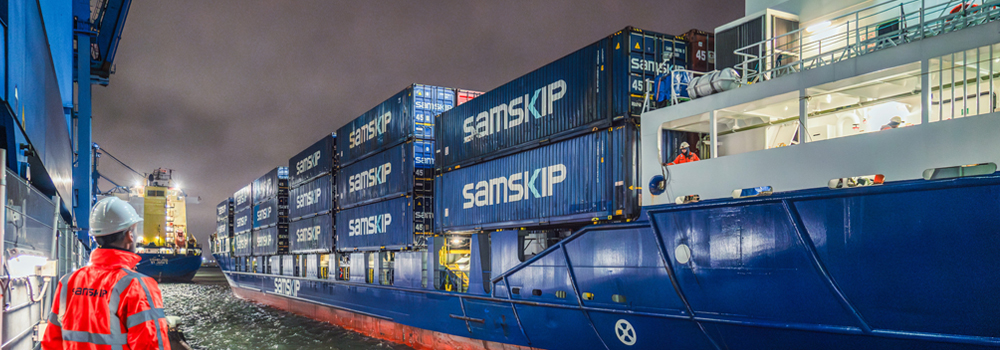Introduction: Samskip’s Commitment to Sustainability
Samskip, a global logistics company renowned for its multimodal transport solutions, and a pioneer in sustainable logistics, has been investing in alternative fuels and technologies for many years. Samskip is also known for its recent innovation, “the Samskip SeaShuttles”, which are currently being built and will be the world’s first hydrogen-powered container vessels. They will be completely emission free and are expected to arrive within the next two years.
Samskip has long recognized the critical importance of sustainability in shaping the future of logistics and the environment. With a corporate ambition to achieve carbon neutrality by 2040, Samskip’s efforts are a testament to its enduring commitment to a sustainable planet.
But at the heart of this transition lies not only technology and innovation but also the people who drive it. At Samskip, sustainability is as much about empowering its workforce as it is about advancing new business models. This article will explore not only the company’s pioneering efforts in sustainability but also how Samskip’s people embrace this mission and actively contribute to its success.
Multimodal as a Sustainable Core Component of Samskip’s Business Model
By integrating road, rail, and sea transport, Samskip minimizes its carbon footprint while offering efficient and reliable logistics services. This approach is a crucial first step in reducing CO2 emissions, as it optimizes the energy efficiency of the network, and favors the use of the least carbon intensive modes of transport; electric trains, inland barges, and seagoing vessels. At a competitive price, multimodal solutions can reduce CO2 emissions by up to 80% when compared to road transport. In addition, it reduces road congestion, local pollution and increases safety in urban areas.
Samskip has built the largest multimodal network in Europe, which not only meets the needs of its customers but also contributes to global efforts to combat climate change. Samskip’s role as a specialist in multimodal transport uniquely positions the company to drive sustainable logistics solutions across Europe and beyond.
People as the Heart of the Sustainability Transition
While the organization leads with technology, its people are at the core of making sustainability a reality. “Like with many things, driving for increased sustainability within an organization is driving a cultural change, which can only be done by engaged employees” says Seline Berns-Oost Lievense, Chief People Officer at Samskip”. This cultural shift ensures that everyone in the company contributes to the journey toward a greener future.
At Samskip, sustainability is not merely a directive from the top, but a shared vision embraced across the organization. Employees are encouraged to play an active role in shaping the company’s sustainability goals. Through comprehensive engagement, Samskip ensures that everyone—from the leadership to the ground staff—feels responsible for and committed to improving the company’s environmental and social impact.
Innovative Sustainable Practices Backed by a Passionate Workforce
One of the most significant initiatives Samskip has taken to reduce its environmental impact is the development of two hydrogen-powered short-sea container ships through the “SeaShuttle” project, which is set to revolutionize the industry by 2026. These ships will be the world’s first hydrogen-powered, zero-emission container vessels. This, along with initiatives like using shore power in ports, biofuels, and carbon capture filters, showcases Samskip’s commitment to doing its part in transforming an industry that aims to reduce its environmental impact.
However, these technological advancements would not be possible without a team that understands the value of these innovations. Samskip’s workforce—trained in sustainable technologies and driven by a shared commitment to the environment—ensures these initiatives succeed.
Involving Everyone in the Sustainability Journey
Too often, sustainability strategies are confined to boardrooms. At Samskip, however, this is not the case. Samskip favors a bottom-up approach where the voices of employees, customers, and partners shape the company’s sustainability direction. Through internal research and open forums, Samskip asks its employees: “What matters to you?” This feedback directly informs the company’s sustainability strategy, ensuring it is relevant and resonant with everyone involved.
Samskip’s Leadership in the Transition towards a Sustainable Future.
Samskip’s leadership extends beyond its own operations. The company actively facilitates and supports other businesses in their sustainability journeys. A prime example is the Samskip Sustainability Day, an event that brings together industry leaders, partners, politicians and stakeholders to discuss sustainable practices in logistics. This initiative underscores Samskip’s role to inspire change, encouraging others in the industry to take responsibility for a sustainable future.
Navigating the complexities of Environmental, Social, and Governance (ESG) challenges is another area where Samskip excels. In a time when the shipping industry is under increasing scrutiny for its impact on these topics, Samskip stands out by embracing ESG principles and leads by example. The company’s transparent reporting, ethical business practices, and commitment to social responsibility further solidify its position as a leader in the sustainable logistics sector.
Conclusion: A Commitment to the Future
As the world grapples with the pressing challenges of climate change, Samskip’s unwavering commitment to sustainability offers a beacon of inspiration. By prioritizing not only innovative technologies but also the people behind them, Samskip is demonstrating that true sustainability is about more than reducing emissions—it’s about nurturing a culture that believes in and actively contributes to its own future.
By choosing Samskip, customers are not just selecting a logistics provider—they are partnering with a company that is shaping the future of sustainable transport, driven by the power and passion of its people.

